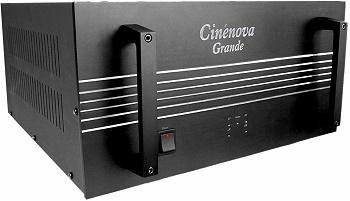Introduction
Earthquake Sound is renown for producing powerful amplfiers, in part because they started in the car audio business, where high power is what customers want. They branched into home audio and began marketing multi-channel power amplifiers for the home theater market. We reviewed the Cinénova Grande in a five-channel configuration in 2004, and the seven-channel version in 2006. In both cases, the rated output per channel was 300 watts RMS.
The latest iteration is rated at 360 watts RMS output per channel.
Specifications
- Design: Five-Channel Power Amplifier, Class AB
- Power: 360 Watts RMS x 5 into 8 Ohms, 610 Watts into 4 Ohms, 810 Watts into 2 Ohms
- MFR: 5 Hz – 50 kHz, ± 0.1 dB
- THD+N: 0.003% at 1 Watt
- Inputs: XLR and RCA
- Input Impedance: 28 kOhms Unbalanced RCA, 48 kOhms Balanced XLR
- Outputs: Five-way Speaker Binding Posts
- Dimensions: 9.25″ H x 18″ W x 21″ D
- Weight: 110 Pounds
- MSRP: $4,499 USA
- Earthquake Sound
The Design
The Cinénova Grande utilizes amplifier modules that are complete with power supply capacitors. The only thing that is shared is the 4 KVA (4,000 watts) toroidal power transformer.
The circuit has a fully balanced input stage and a push-pull Class AB output stage.
The rear panel, shown below, illustrates the modular construction. Besides the XLR and RCA inputs (with selector switch), there is a switch to use the module as a low or high-pass amplifier in the case of bi-amplifying your speakers. A small potentiometer is turned (you can do this with your fingers, no small screw driver is required), to get the low or high-pass frequency you wish, in a 20 Hz to 5 kHz range. The middle position on the switch bypasses this circuit for full spectrum use.
The five-way speaker binding posts are plastic, but sturdy. On the right are the grounded AC receptacle and a toggle circuit breaker. So, you don’t need to replace fuses. When powered on, small LEDs on the front panel illuminate.
In Use
Besides testing the updated amplifier circuit, I asked Joseph Sahyoun, President of Earthquake Sound, to bias two of the channels at 10 watts in Class A, as opposed to all the channels in simple Class AB. My request for this is based on the fact that most of us use our home theater setup for two-channel audio as well. One simply sets the SSP or receiver to Stereo, and just the front two left and right speakers get an output signal. Class A means that current is passing through the output stage at all times, and when an input signal (music) comes through, the current is sent to the speaker. At idle (no music), the current is dissipated as heat. Of course, this is inefficient, but audiophiles don’t care.
The sonic benefits of Class A are worth it. Most of the time when we are listening to a CD, the output is 10 watts or less, so that is why we chose that value in the experiment. It worked so well, as you will see below, Earthquake Sound will supply you with a five or seven-channel Cinénova Grande, custom configured with two channels biased as high as 20 watts into Class A. This is very unique, as no other manufacturer has this option.
I tested the Cinénova Grande with an OPPO BDP-83SE/NuForce Universal Blu-ray player, Anthem D2v SSP, Carver Mark IV ribbon speakers, and Paradigm Reference Signature C5 center channel speaker. Cables were Emotiva and Legenburg. For testing with Blu-ray movies, I used the HDMI connection between the player and the SSP. For two-channel listening, I used the stereo analog outputs from the player to the CD pair of analog inputs on the SSP.
There are plenty of movies to test a big multi-channel power amplifier with. Amadeus, for example, has tremendous surround sound when Mozart conducts his operas at the symphony hall. It’s very powerful stuff, and the Cinénova handled it all with ease. The music is thunderous, and every hair on my body stood on end when I cranked the volume up in this movie.

The attack scene in Pearl Harbor is one of my favorite demo samples when friends are over. The machine guns of the Zero’s, the Arizona when its powder magazine explodes, everything about it just begs for a muscle amp, and the Cinénova earns its classification here.

The engine room sounds are what demand power in this movie, besides being a great story with one of the best actors in the world, even if he did speak Russian with a Scottish accent. I sensed no weakness in the sound produced by the amplifier. Maybe the wall studs became a bit rattled, but not the Cinénova.

If you like the sounds of screeching winged creatures and all the violence that goes with an R-rated vampire movie, you would enjoy Van Helsing through the Cinénova.

Now to the stereo music listening. I set the Anthem D2v to the CD analog stereo input and to Stereo mode so that just the front left and right channels were being used, and this meant that only the two Cinénova channels that were biased 10 watts into Class A were being driven. No DSP was applied to the audio from the SSP in this mode. This also meant that my multi-channel SACDs were being listened to in the stereo version on the disc.
Most of the time, 10 watts is enough for casual listening, with just an occasional peak in the 50 watt range. Class A sound is a world of its own. The differences between Class A and Class AB are subtle, but noticeable. There is a smoothness to the sound that Class AB just quite can’t reach. Close but no cigar. Violins have an additional correctness about them. Brass sounds more like brass and less like something that has its edges not quite in focus.
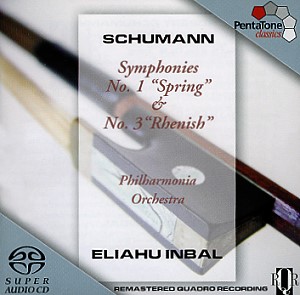
Voices sound absolutely mellifluous with Class A operation, as with this SACD of Rachmaninov’s Vespers. My recommendation is that, if you purchase a Cinénova and like the idea of having two channels of Class A operation, request that they be biased 20 watts into Class A instead of just 10. When I was listening, and I don’t listen to music very loud most of the time, I think the output was edging a bit higher than 10 watts for some passages. Enough that I would re-bias it to 20 watts Class A. Now keep in mind that the amplifier will get rather warm when you bias two channels at 20 watts of Class A. It will be dissipating about 150 watts of heat during quiet passages. So, I suggest getting one of those tiny fans that have a clip on one end and have the air blow over the top of the amplifier to aspirate more air up through the chassis.

On the Bench
I regret to inform you that you are about to be presented with a S*** load of graphs, mainly because I had to test the Class A modules and the normal bias modules, so there are twice as many graphs for you to wade through as you might otherwise. Distortion measurements were made within an 80 kHz bandwidth. Since the amplifier is modular, I only drove one channel for each test.
OK, here we go:
Here is 1 kHz, 5 volts output into an 8 ohm load (3.12 watts), in a normal bias module. Distortion was 0.008% THD+N.

Now, the same test using the Class A module. Notice that although the total amount of distortion was the same as with the normal bias module, the odd-order harmonics were higher with normal bias.
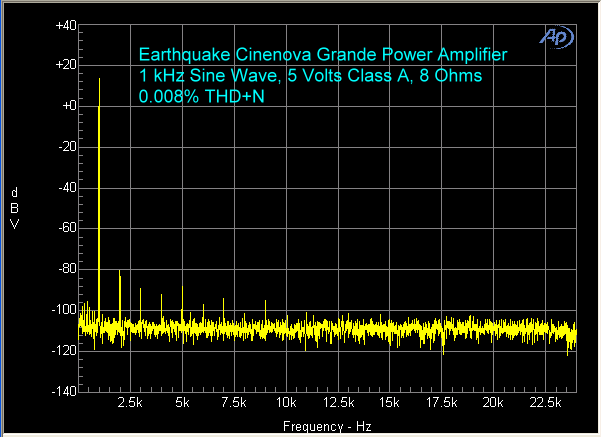
Below are the same tests, but with a 4 ohm load (6.25 watts)
With normal bias, the emphasis on odd-order harmonics is even greater than it was at 8 ohms. This is to be expected, as 4 ohms is a more stressful load. You can see also that there is an absence of the high-order harmonics in Class A. This makes for very pleasant listening, because high-order harmonics make the sound harsh.

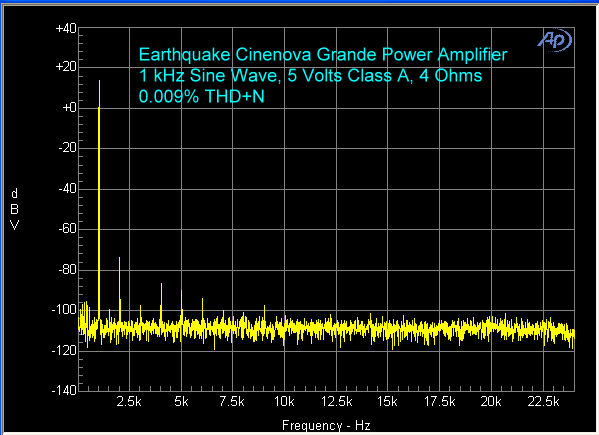
Are you already sold on getting the amp with two of the modules biased into Class A for your two-channel listening? I thought so.
So, now let’s move into 20 volts output, which for an 8 ohm load, is 50 watts, and for 4 ohms, 100 watts, well outside our 10 watt Class A bias in those two modules.
The distortion was about the same for both amplifier modules, both at 8 and 4 ohm loads, because the power output was beyond the 10 watts of Class A, and the modules were both now operating in Class AB.
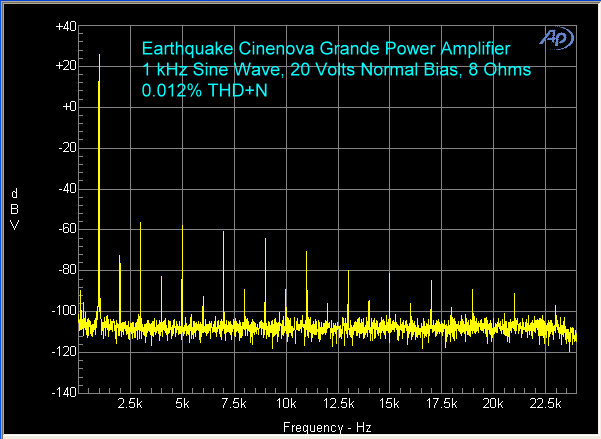
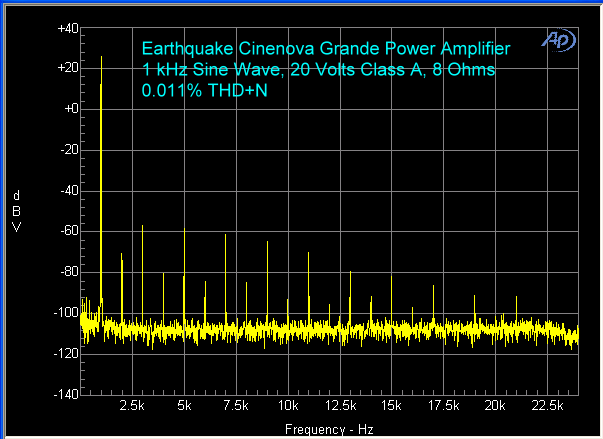
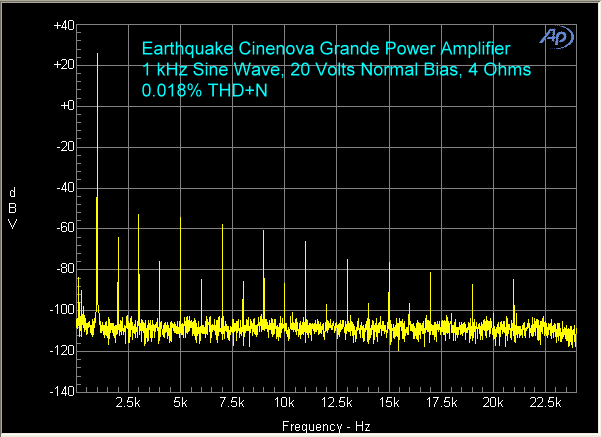
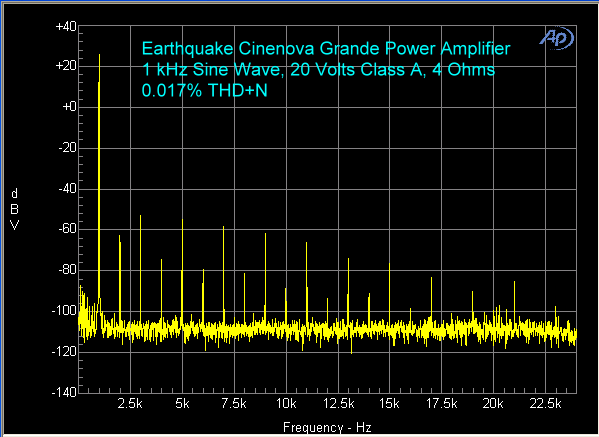
For IMD, the differences were dramatic. Notice the relative size of the harmonic peaks all the way out to 42 kHz. The actual measurement number was about the same, but it only included peaks within 250 Hz on either side of the 7 kHz fundamental. This is why it is very important to show the actual graphs.
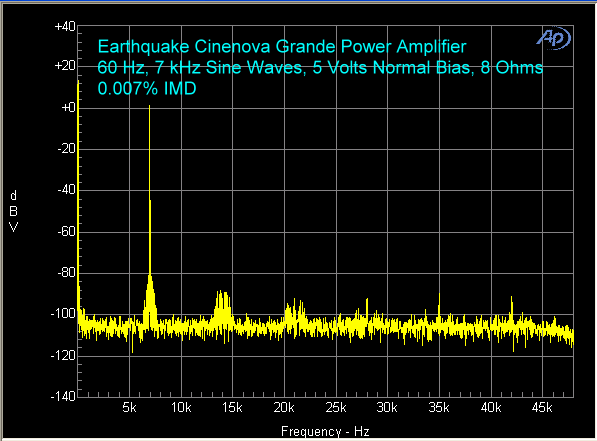
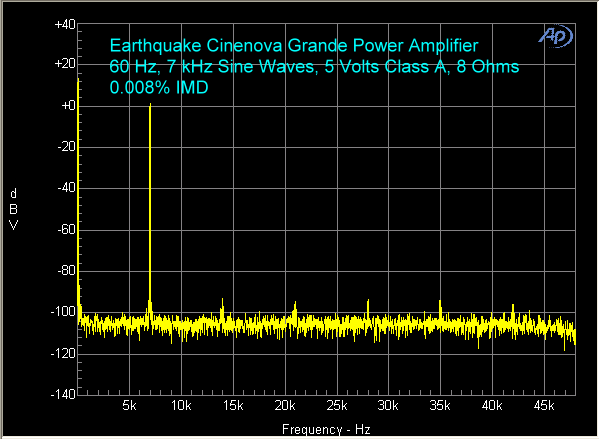
At 20 volts, again, we are beyond the 10 watts of Class A, so the performance between the normal bias module and the Class A module was the same for 8 and 4 ohm loads.
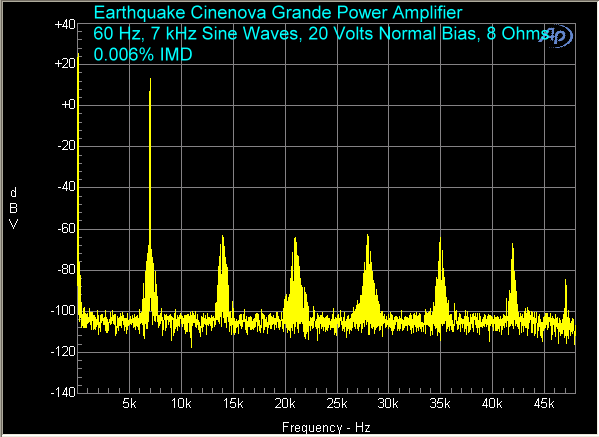


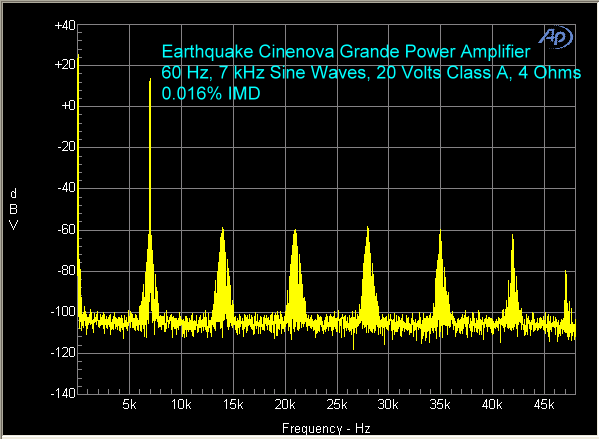
THD+N vs. Frequency, using a normal bias module, showed low distortion all the way out to 50 kHz. I used one of my Carver Mark IV speakers as the load.
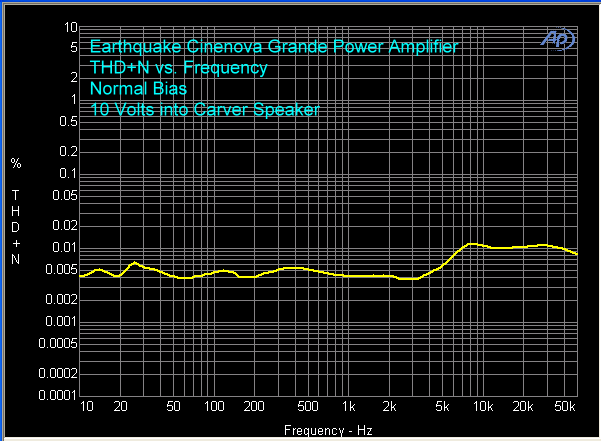
Here is an impedance plot of the Carver speaker.

The measured frequency response at 20 volts, and a normal bias module, was down 0.2 dB at 20 kHz into an 8 ohm load, and down 0.4 dB using a 4 ohm load.
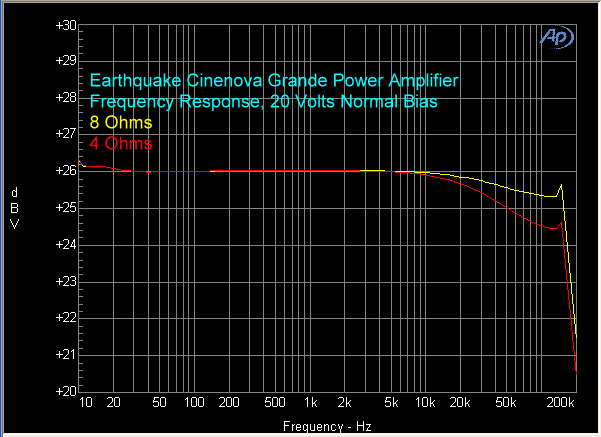
Power output is shown below. Using a normal bias amplifier module, at 8 ohms, the soft knee was at 20 watts, the hard knee (the practical output of a power amplifier) at 320 watts, and clipping (1% THD+N) occurred at 360 watts. At 4 ohms, the soft knee was at 30 watts, the hard knee at 500 watts, and clipping was at 605 watts. This is about right on specification.
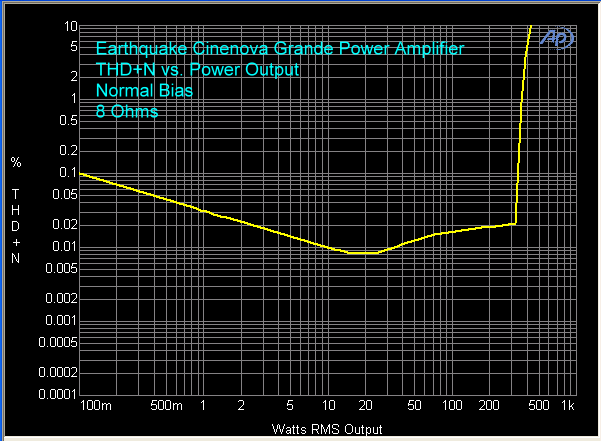

One more graph to show. This one illustrates what you give up in power output into 8 ohms when you bias a module 10 watts into Class A. You can see that instead of the hard knee being at 320 watts, as it was in normal bias, it was at 280 watts with 10 watts of Class A bias. This is a 40 watt reduction, which is what we would expect (Class A operation is very inefficient). So, if you purchase a Cinénova Grande, and bias two modules 20 watts into Class A for your two-channel music listening, you can expect the hard knee to be 80 watts less than it would be in normal bias, or 240 watts. Is it worth the loss in total power? I think that after you hear what you get with Class A bias, you would agree that the answer is yes.
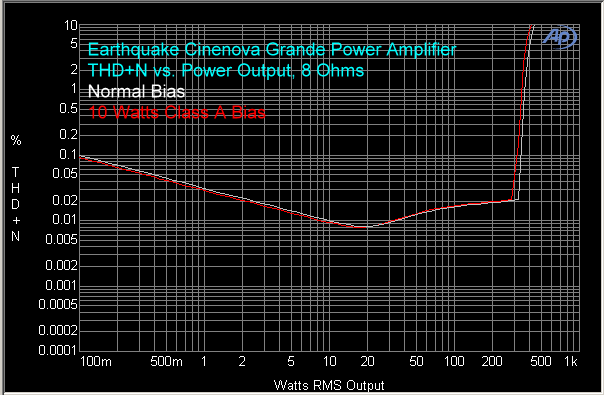
Conclusions
Earthquake Sound continues to improve its products, and the Cinénova Grande is no exception. It has massive, clean, detailed power capability, and if you like, custom biasing of two channels into your choice of 10 or 20 watts Class A operation. This feature alone makes the Cinénova unique in the marketplace.



